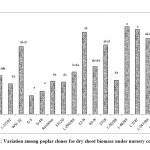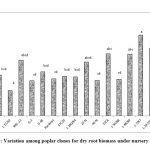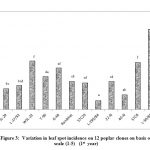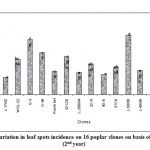Introduction
Populus deltoides Bartr. Ex Marsh., commonly called eastern cottonwood or poplar, is one of the most widely planted exotic tree species. It belongs to family Salicaceae, and is naturally distributed over the forests of Northern Hemisphere. Among the native six species of this genus viz. P. ciliata, P. laurifolia, P. gambles, P. euphratica, P. alba, P. jaquemontiana, none of these is commercially important for timber production. Forest Research Institute, Dehradun introduced Populus deltoides in India from United Kingdom.1 Poplar is fast growing, multipurpose tree species and can be harvested at short rotation of 7-8 years. Several promising clones [G series (Australian), SC, D and ST series (American) were identified and planted extensively in north Indian states.2,3 Due to specific photoperiodic and temperature requirements, poplar has only a limited zone for plantation in India and has shown a potential for growth only in areas lying in north of 280 N latitude in states of Uttar Pradesh, Uttrakhand, Punjab, Haryana and Himachal Pradesh,4 but also tried in Chhattisgarrh, Bihar and Maharashtra.
Poplar can contribute towards production of wood for industries and other commercial purposes, besides maintaining ecological balance in great extent. The poplar wood serve as raw material for fibre board, match sticks, plywood and packing industries, for making of pulp and paper, furniture and the artificial limbs, etc. The characters like clean bole, winter deciduous, multiple uses, soil improving properties, compatibility with agricultural crops and high economic returns make the species most ideal for agroforestry. Both block and boundary plantations of poplar have come up at large scale in north-western India.
New introductions and breeding work in India was initiated by Forest Research Institute, Dehra Dun, Uttrakhand State Forest Department, Lal Kuan, University of Horticulture and Forestry, Nauni and WIMCO seedlings Ltd. According to an estimate, 90% of the poplar plantations in India were based on the three clones. It is recommended that annual replacement of 5 to 10 % of existing clones with new superior clones to maintain the genetic diversity in fields, sustain production and reduce the outbreak of diseases and insects5. Poplar plantations in a region have only small number of elite clones.6,7 Monoculture plantations increases the risk due to biotic stress such as leaf spots, cankers and rusts. With the change in rainfall patterns observed over north western plain zone in India, sleeper pathogens are becoming active and outbreak of foliar diseases has become more evident.8,9 Amongst foliar blights, Bipolaris spp., Myrothecium roridum, Alternaria alternata, Phoma sp., Curvularia spp., Sclerotium rolfsii, Rhizoctonia sp. and Fusarium solani have been found associated with poplar nurseries and plantations under Punjab conditions.10,11,12 Emergence of new aggressive virulences in the pathogen can circumvents the resistance in the host and may lead to failure of plantations. Commercial poplar clones G-3, 3651 and 111101 suffered incremental damage in Haryana and Uttarakhand in ninetees due to foliar blight caused by Bipolaris spp.13
There is a continuous need to evaluate/screen and introduce new clones and test them under different agro-climatic regions to find promising ones for diversification and sustainable wood production. This study was planned to evaluate poplar clones under the nursery conditions for growth, wood traits and tolerance to diseases.
Materials and Methods
Study Site
The study was carried out at research farm of Department of Forestry and Natural Resources, at main campus of Punjab Agricultural University, Ludhiana. The site is located at latitude of 30o56’ N, longitude 75o52’ E and at 247 m above mean sea height. The climate of this region is sub-tropical with hot and dry summers and very cold winters. The mean annual rainfall is 732 mm and almost 80 per cent of which occurs during monsoon season (July to September). The topography is plain with well drained, deep soils (inceptisols soils, USDA classification). The texture of soils is sandy loam having with lower humus content with soil pH of 8.0. The farm has good irrigation facility, mainly by tube well with occasional irrigations from canal water.
Experimental Details and Observations
The nursery trial was conducted for two years. During 1st year, 12 poplar clones (WSL-29, L-17/92, WSL-22, T-90, G-48, Ranikhet, S7C20, L-290/84, 22-N, 40-N, S7C8 and L-50/88) and 16 clones (added five new clones G-3, L-48/89, L-7/87, L-247/84 and L-34/82 and removed one poorly performing clone (T-90) were tried in 2nd year. Uniform cuttings (20 cm length and 3 cm diameter) were planted following randomized block design with five replications and plot size of 16 cuttings. The field was kept moist with light irrigations till the sprouting of the cuttings and all the recommended practices of weeding, irrigation, fertilizer application, etc were applied uniformly to all the plots throughout the year. The plant height was recorded from the ground level to the tip with a long measuring scale and collar diameter was measured by vernier caliper at 5 cm above the ground level. Two randomly selected plants were digged from the soil. The shoot and root biomass was weighed after putting the samples into oven (70oC) for more than 48 hrs. The specific gravity was calculated by following Maximum-moisture method14. The wood samples were macerated in a solution of 10 % chronic acid and 10% nitric acid for 24 hours and washed thoroughly with distilled water. The washed pulp was stained with saffranin (1 % alcohol) and fiber length and fiber width was measured under the compound microscope. Randomly selected plants were observed for diseases (Pseudo cercospora spp., Alternaria spp. and Drechslera spp) using 0 to 5 scale on the basis of per cent incidence as given below.
|
Disease Score |
Per cent Incidence |
|
0 |
No disease |
|
1 |
up to 10 % |
|
2 |
10 % to <20 % |
|
3 |
>20 % to 40 % |
|
4 |
>40 to 60 % |
|
5 |
>60 % |
The data on growth, wood traits and disease score were subjected to statistical analysis using CPCS statistical software, developed by Punjab Agricultural University, Ludhiana under Completely Randomized Block Design (CRBD). The means were compared with LSD (p=0.05).
Results and Discussion
The data on plant height and collar diameter for both the years are given in Table-1. Both the growth parameters i.e. height and collar diameter witnessed significant differences among the clones for both the years. During the 1st year, clone 22-N registered the highest value (4.79 m) and was significantly superior to all clones except L-290/84 and L-50/88. The maximum value (3.68 cm) for collar diameter was recorded by clone L-290/84 which was however at par with five other clones i.e. L-50/88, 22-N, WSL-22. Ranikhet and S7C8.. The bottom rank for height and collar diameter was in case of L-17/92 with respective values of 3.83 m and 2.60 cm. The plant height varied from 4.31 to 5.38 m during 2nd year. Clone L-7/87 recorded the top rank for height with value of 5.38 m and was superior to all clones except L-34/82. Clone L-34/82 was however at par with seven other clones i.e. 22-N, L-48/89, S7C8, WSL-22, L-247/84, L-50/88 and Ranikhet. The collar diameter varied from 2.69 to 3.22 cm. Clone L-7/87 again registered the highest value (3.22 cm) and was at par with two clones L-48/89 (3.09 cm) and L-247/84 (3.05 cm). The lowest value for height was recorded by L-17/92 (4.31 m), whereas clone 40-N registered the bottom rank for collar diameter with value of 2.80 cm.
Table 1: Mean values of growth traits of poplar clones planted under nursery conditions for two years
|
Clone |
1st Year |
2nd Year |
||
|
Height (m) |
Collar Diameter (cm) |
Height (m) |
Collar Diameter (cm) |
|
|
WSL-29 |
4.26 |
3.07 |
4.76 |
2.91 |
|
L-17/92 |
3.83 |
2.60 |
4.31 |
2.82 |
|
WSL-22 |
4.28 |
3.45 |
5.07 |
2.97 |
|
T-90 |
4.12 |
3.16 |
– |
– |
|
G-3 |
– |
– |
4.42 |
2.80 |
|
G-48 |
4.18 |
3.00 |
4.75 |
2.83 |
|
Ranikhet |
4.19 |
3.42 |
4.98 |
2.99 |
|
S7C20 |
3.97 |
3.00 |
4.57 |
2.77 |
|
L-290/84 |
4.48 |
3.68 |
4.93 |
2.90 |
|
22-N |
4.79 |
3.54 |
5.13 |
2.94 |
|
40-N |
3.84 |
3.10 |
4.95 |
2.69 |
|
S7C8 |
4.31 |
3.40 |
5.09 |
2.89 |
|
L-50/88 |
4.48 |
3.64 |
5.01 |
2.98 |
|
L-48/89 |
– |
– |
5.10 |
3.09 |
|
L-7/87 |
– |
– |
5.38 |
3.22 |
|
L-247/84 |
– |
– |
5.02 |
3.05 |
|
L-34/82 |
– |
– |
5.18 |
2.90 |
|
CD (p=0.05) |
0.38 |
0.39 |
0.22 |
0.20 |
The present study showed that ample variation existed among the clones for height and diameter. Such a significant variation may be due to their distinct genetic constitution. Earlier studies conducted in this region and elsewhere also support the findings. Significant difference among the P. deltoides clones for tree height was reported.15 The significant genetic variation for height and collar diameter among sixteen clones of P. deltoides in nursery were also found in a study conducted at Ludhiana for three consecutive years16. Similarly the variation among poplar clones was also reported from many other regions of India and abroad.17,18,19
The dry shoot biomass given in Fig 1 showed the significant differences among the poplar clones. L-48/89 registered the top rank with the value of 611.7 g/ plant. It was superior to others except seven clones i.e. L-7/87, 22-N, L-247/84, L-34/82, S7C8, 40-N and WSL-22. The lowest value was recorded in the clone G-3 (485.0 g/plant). Values for dry root biomass varied from 171.2.0 gm to 238.8 gm (Fig 2). The maximum dry root biomass was noticed in clone L-7/87 (238.8 gm) which was at par with L-247/84, S7C8, L-48/89, WSL-22, 22-N and L-34/82. Again, the lowest value (183.0 g/plant) was recorded by clone G-3. The perusal of results indicated that significant variation existed among the clones for shoot and root biomass (Fig 1, Fig 2). Such variation may be due to their genetics and may be exploited for identification of high yielding clones. Clones like L-7/87, S7C8, L-247/84 and L-48/89 recorded relatively higher biomass values. The findings of study20 conducted on P. deltoides and P. deltoides X P. nigra was also in conformity with the findings of the present study. Significant variation for dry shoot weight, and dry root weight among fifteen clones of P. deltoides under nursery conditions while conducting a study at Hisar21. Similarly, another study22 examined twelve poplar genotypes and found that above ground biomass production varied significantly among genotypes. The differences among the clones may be due to their varying genotypes, as uniform cultural conditions were applied to the plants.
 |
Figure 1: Variation among poplar clones for dry shoot biomass under nursery conditions Click here to View Figure |
 |
Figure 2: Variation among poplar clones for dry root biomass under nursery conditions Click here to View Figure |
The data presented in Table 2 showed the significant difference among the clones for fibre length and specific gravity. It was observed that clone WSL-29 recorded the maximum value (0.936 mm) for fibre length which was statistically higher than other clones except clone WSL-22 (0.933 mm), L-17/92 and L-50/88. Minimum value was noticed in clone S7C8 (0.798 mm) and at par with four other clones. The differences among clones for fibre width were not significant. Clone L-290/84 recorded the top rank for specific gravity with value of 0.448 and was at par with four clones i.e. 40-N, G-48, L-50/88 and T-90. The lowest value was attained by clone S7C20 which was at par with clones WSL-22 and L-47/92. The results are in conformity with the earlier studies from this region23,24. The significant interclonal variations in anatomical parameters and specific gravity of 18 clones of P. deltoides were found25. Significant variation among the twenty clones of P. deltoides for wood chacteristics was found26. Another study27 also reported the significant variation among clones of P. deltoides for specific gravity and fibre dimensions. The significant genetic variation for fiber length and wood density was also noticed in P. deltoids,28 P. tomentosa,29,30 Populus x euramericana31 and among hybrid poplar clones.32
Table 2: Variation in wood traits among poplar clones
|
Clones |
Fibre length(mm) |
Specific gravity |
|
WSL-29 |
0.936 |
0.383 |
|
L-17/92 |
0.910 |
0.368 |
|
WSL-22 |
0.933 |
0.408 |
|
T-90 |
0.835 |
0.424 |
|
G-48 |
0.866 |
0.438 |
|
Ranikhet |
0.874 |
0.404 |
|
S7C20 |
0.839 |
0.351 |
|
L-290/84 |
0.849 |
0.448 |
|
22-N |
0.830 |
0.393 |
|
40-N |
0.865 |
0.446 |
|
S7C8 |
0.798 |
0.394 |
|
L-50/88 |
0.891 |
0.431 |
|
CD (p=0.05) |
0.54 |
0.37 |
The plants were evaluated using 0 to 5 scale on the basis of visual observations for incidence of leaf spot disease during the months of July to October for two years. Leaf spot included different species of Pseudocercospora, Alternaria and Drechslera. Amongst 12 clones evaluated during first year, clone L-290/84 showed significantly (p<0.05) highest resistance to foliar leaf spots with disease score of 1.3, closely followed by clone 40-N with score of 1.55 (Fig 3). During, the second year clone L-17/92 exhibited maximum resistance to leaf spot with average disease score of 1.7 and it was statistically placed together with WSL-29, Ranikhet, L-290/84, 22-N, 40-N, S7C8, L-247/84 and L-48/89 clones (Fig 4). Clone L-50/88 proved most susceptible in both years with the average disease score of 4.0 and 3.4, respectively (Fig 4). The perusals of results show that significant variation among clones for leaf spot incidence during both the years. Disease performance of some clones viz. L-290/84, L-17/92 and 40-N was not consistent in the years of evaluation. It may be attributed to variable response of the genotypes with ageing or influence of different climatic conditions prevalent in these years. Based on the response of clones L-290/84, 40-N, WSL-29, Ranikhet, L-290/84, 22-N, 40-N, S7C8, L-247/84 and L-48/89 to leaf spots, these can be further used in breeding programmes.
 |
Figure 3: Variation in leaf spot incidence on 12 poplar clones on basis of scale (1-5) (1st year) Click here to View Figure |
 |
Figure 4: Variation in leaf spots incidence on 16 poplar clones on basis of scale (1-5) (2nd year) Click here to View Figure |
Foliar diseases of poplar can be controlled in nurseries with fungicides but it is difficult in plantations due to delay in early detection and inappropriate coverage of foliage with spray mixture. Therefore, incorporation of stable resistance against foliar blights and cankers and extensive screening is necessary for identifying and growing health clones and enhancing their field durability.33,34 Significant variation among clones of P. deltoides, P. robusta, P. yunnanensis, P. trichocarpa, and P. eugenei has been reported for leaf spot incidence.35 Similarly, different disease reaction has been reported in commercial clones of P. deltoids, where WSL-39 came out to be resistant to foliar pathogens.36,37 classified poplar clones W39, W108, W22, Udai, W109, FRIAM 70 and WSL 22 as resistant to foliar diseases. Long term economic benefits can be gained only if clones with desirable characteristics are taken to field. The present study has revealed significant variation for all the growth traits and reaction to disease incidence. The clones which looked promising were L-48/89, 22-N, 40-N, L-290/84, and WSL-22. Clone L-50/88 had fast growth rate but was relatively susceptible to disease. The shortlisted clones need to be tested at multiple sites.
Conclusion
The present study has revealed significant variation for all the growth traits and reaction to disease incidence. Poplar clones L-290/84, 40-N, WSL-29, Ranikhet, L-290/84, 22-N, 40-N, S7C8, L-247/84 and L-48/89 were found promising as resistant stocks against leaf spots. Overall, the clones which looked promising based on growth, wood traits and resistance to leaf spot disease were L-48/89, 22-N, 40-N, L-290/84, and WSL-22. Clone L-50/88 had fast growth rate but was relatively susceptible to disease. The shortlisted clones need to be tested at multiple sites and these can be further used in tree breeding programmes.
Conflict of Interest
There is no conflict of interest.
References
- Khanna P., Karnatak D.C. and Chandra A. Trials of poplar clones in Haryana village farms-early evaluation. Ind Forester, 1996; 122: 577-583.
- Kumar D., Singh N.B., Srivastava S.K., Rawat G.S. and Mohn D. Improvement of Populus deltoides clones in India. Ind Forester, 1999; 125: 245-263.
- Thakur S., Thakur S., Jha S.K. and Sharma D. Variability for first year growth in forty nine international clones of Populus deltoides Int J Chem Stud, 2019; 7: 980-982.
- Mathur R.S. and Sharma K.K. Poplar in India. Ind Forester, 1983; 109: 591-631.
- Bishir J. and Roberds J. H. On numbers of clones needed for managing risks in clonal forestry. Forest Genetics, 1999; 6(3):149-155.
- Libby W.J. and Ahuja M.R. Micropropagation and clonal options in forestry. In: Ahuja, M.R., Ed. Micropropagation of woody plants. Dordrecht, Kluwer Academic Publisher, 1993; pp. 425-442.
- Sharma R.C. Poplar diseases in India and their management. ENVIS For Bull, 2009; 9(1): 87-99.
- Chakraborty S., Luck J., Hollaway G., Freeman A., Norton R., Garrett K.A., Percy K., Hopkins A., Davis C. and David Karnosky F. Impacts of global change on diseases of agricultural crops and forest trees. CAB Reviews: Perspectives in Agriculture, Veterinary Science, Nutrition and Natural Resources, 2008; (3) No. 054.
- Singh P., Sharma V.K, Rattan G.S. and Mohan C. Forest tree diseases in relation to climate change. Indian J Eco, 2011; 38: 232-34.
- Sangha K.S., Rattan G.S., Luna R.K., Singh P. and Makkar G.S. Status and distribution of insects and diseases of poplar (Populus deltoides). Ind Forester, 2007; 133:166-177.
- Singh Y.P., Uniyal K., Bagwari A., Kavita, Barthwal S., Dhiman R.C. and Gandhi J.N. Status of poplar diseases in India. Forestry Bulletin, 2012; 12: 84-99.
- Rattan G.S., Singh P. and Chowdary R.N.V.V. Studies on Myrothecium roridum-an emerging problem of tree species in the nurseries of Punjab. Pl Dis Res, 2012; 27(1): 60-65.
- Chauhan S. and Pandey B.N. A new leaf blight of Populus deltoides caused by Bipolaris maydis. Indian Phytopathology, 1992; 45: 130-33.
- Smith D.M. (1954) Maximum moisture content method for determining specific gravity of small wood samples, USDA Forest Service, 1954; Rept. NO. 2014, 8 p.
- Sidhu D.S. and Dhillon G.P.S. Field performance ten clones and two sizes of planting stock of Populus deltoides on the indo-gangetic plains of India. New For, 2007; 34: 115-122.
- Sidhu D.S. Genetic evaluation of Populus deltoides (Marsh) clones in nursery under Punjab conditions. Ind J For, 1996; 19: 21-25.
- Singh B. and Singh N.B. Variation and genetic correlation in growth and branching characters of Populus deltoides clones. Ind Forester, 2013; 139: 667-673.
- Stener L.G. and Westin J. Early growth and phenology of hybrid aspen and poplar in clonal field tests in Scandinavia. Silva Fennica, 2017; 51:1-22.
- Ahmed A.K.M., Jiang L., Wang F., Chen S., Zhou X., Pei X., Zhao X. and Qu G. Variation analysis of growth traits of four poplar clones under different water and fertilizer management. Journal of Forestry Research, 2020; 31: 45–55.
- Dowell R.C., Gibbins D., Rhoads J.L. and Pallardy S.G. Biomass production physiology and soil carbon dynamics in short-rotation-grown Populus deltoides and deltoides × P. nigra hybrids. For Ecol & Manage, 2009; 257: 134-142.
- Singh R. and Bangarwa K.S. Evaluation of various clones of Populus deltoides for root and shoot characters under nursery conditions. Ind J For, 2006; 29: 79-83.
- AfasA., Marron N., Ceulemans R. Variability in Populus leaf anatomy and morphology in relation to canopy position, biomass production, and varietal taxon. For Sci, 2007; 64: 521-532.
- Dhillon G.P.S., Sidhu D.S. and Singh A. Genetic variation in wood fibre length in poplar (Populus deltoides). Ind. J. Agroforestry, 2008; 10: 45-47.
- Pande P.K. and Dhiman R.C. (2012) Variations in wood anatomical properties and specific gravity of half sib progenies of Populus deltoides. J For Res, 2012;23: 491–496.
- Chauhan L., Gupta S., Madhwal R.C., Pandey R. and Pal M. Interclonal, intraclonal and within tree variation in wood parameters of different clones of Populus deltoides. Ind Forester, 2001; 127: 777-784.
- Venkaiah K., Chauhan R. and Khurana D.K. Wood characteristics of twenty poplar clones grown under short rotation intensive culture in Himachal Pradesh. J Timber Dev India, 2003; 52: 3-6.
- Kandpal V., Pande P.K. and Dhiman R.C. Genetic analysis for wood parameters in full-sib seedling progeny clones of Populus deltoides. Ind Forester, 2019;145: 549-555.
- Dhillon, GPS and D S Sidhu. 2007. Genetic variation in wood specific gravity in poplar (Populus deltoides) from two locations in Punjab. Ind. J. Forestry 30 (1):5-7.
- Song W., Zhang Z.Y. and Xu J.R. Study on inheritance and variation of wood basic density of Populus tomentosa clones. J Beijing Forestry Univ, 1997; 6: 8-18.
- Song W., Zhang Z., Dvorak W.S., Xu J.R. and Li X.G. Study on heritance and variation of wood fibre length of Populus tomentosa J Beijing Forestry University, 1997; 6: 21-34.
- Beaudoin M., Hernandez R.E., Koubaa A. and Poliquin J. Interclonal, intraclonal and within tree variation in wood density of poplar hybrid clones. Wood and Fibre Science, 1992; 24: 147-153.
- Zhang S.Y., Yu Q., Chauret G. and Koubaa A. Selection for both wood properties in hybrid poplar clones. For Sci, 2003; 49:1-8.
- Feau N., Mottet Marie-Josée, Périnet P., Hamelin R.C. and Bernier L. Recent advances related to poplar leaf spot and canker caused by Septoria musiva, Can J Plant Path, 2010; 32: 2, 122- 134. http://dx.doi.org/10.1080/ 07060661003740009
- Dhiman R.C. and Gandhi J.N. Development and release of clones: a case study of screening 1999 poplar breeding population at Wimco Seedlings. Tree Science, 2015; 34(2): 1-11.
- Sharma R.C. and Sharma S. Reaction of poplar germplasm to Cladosporium leaf spot. Ind Forester, 2001; 127: 160-162.
- Mishra S. Disease status and their management of poplar nurseries in Northern India. Ph.D. thesis. Forest Research Institute Deemed University, Dehradun, 2011; 148p
- Kumar R., Kumari B., Bhardwaj K.K., Kumar A. and Kumar T. Study on growth and phenotypic characters of different clones of poplar (Populus deltoides) in nursery. Int J Curr Microbiol App Sci, 2017; 6(12): 1840-1848.

